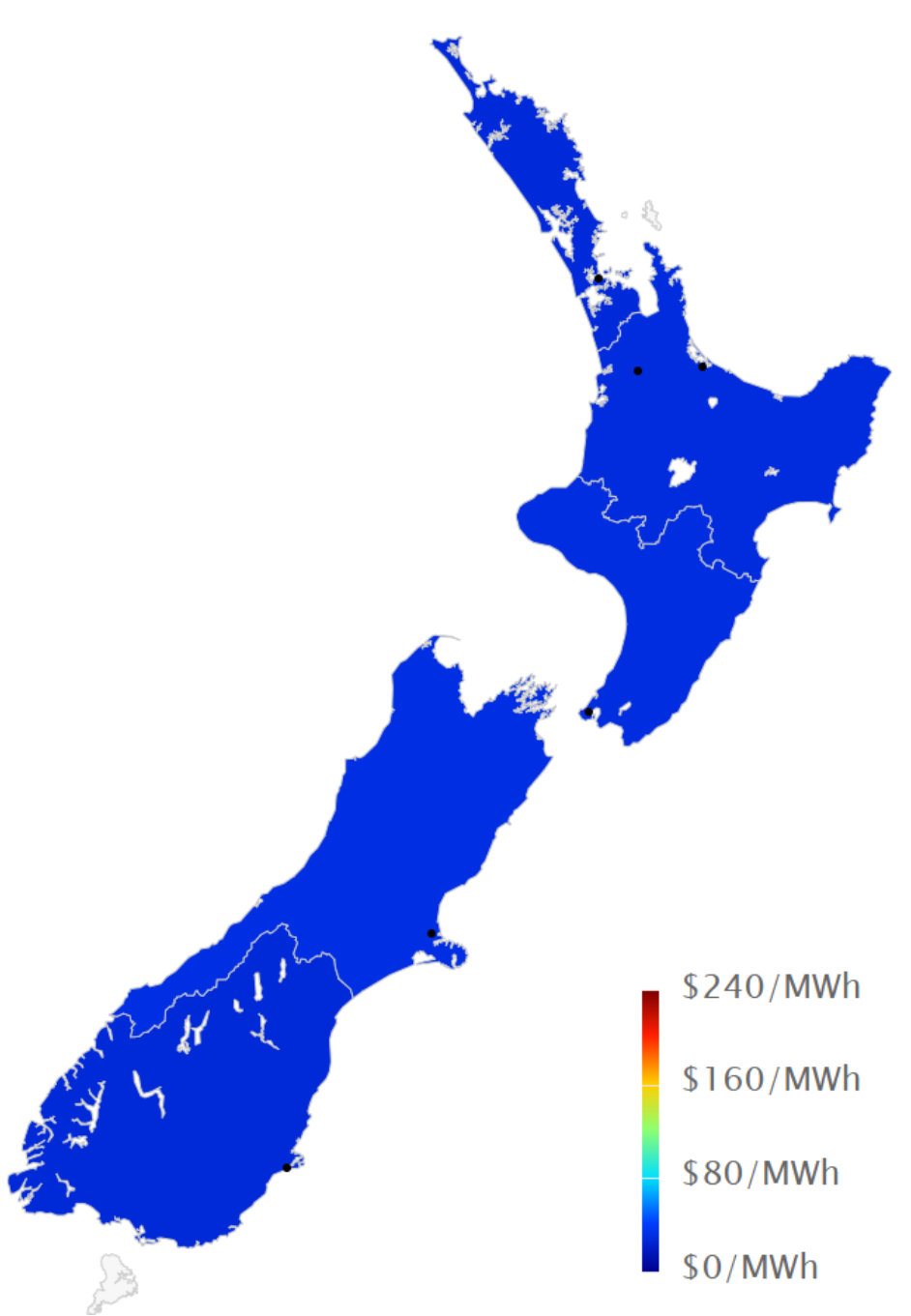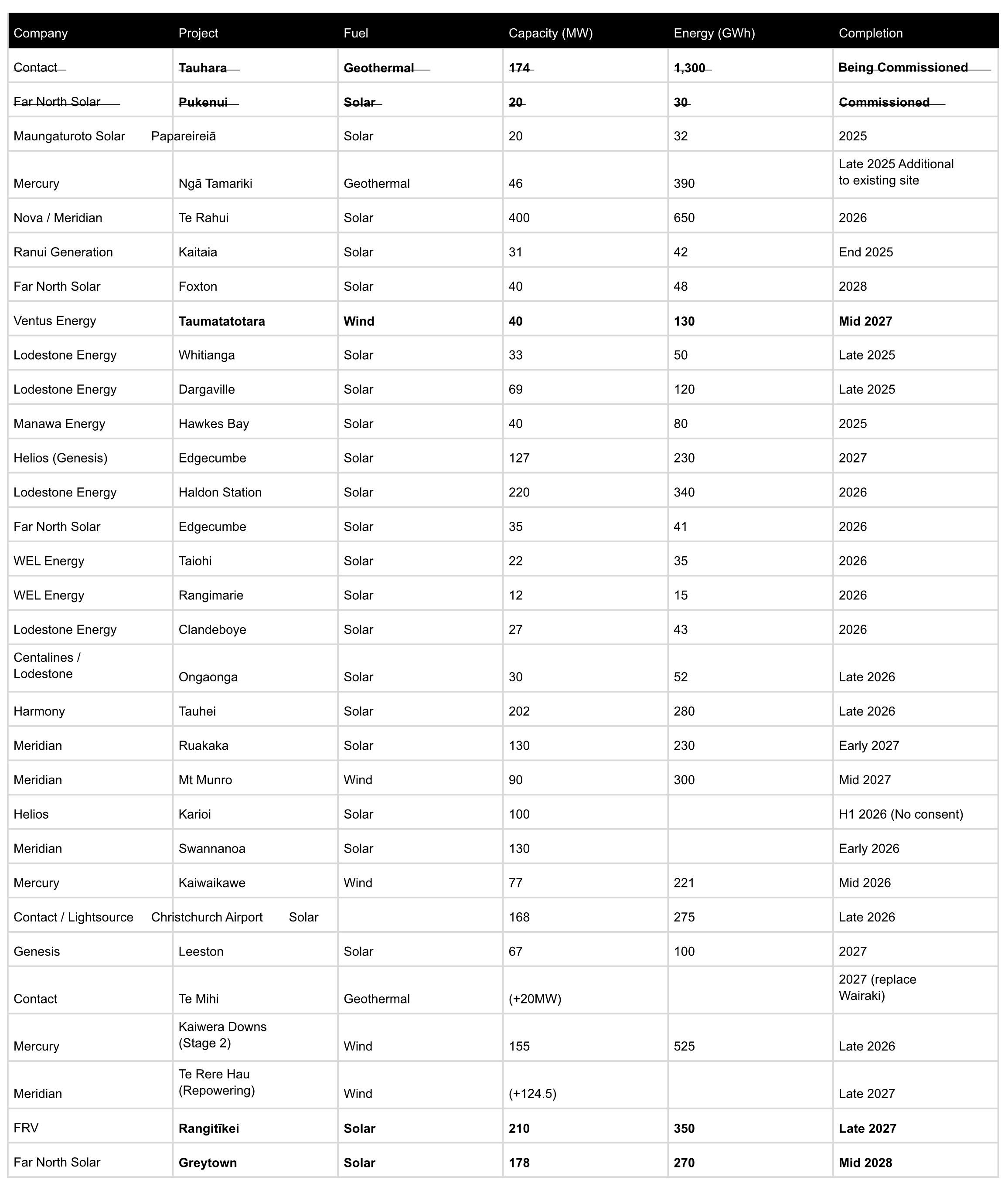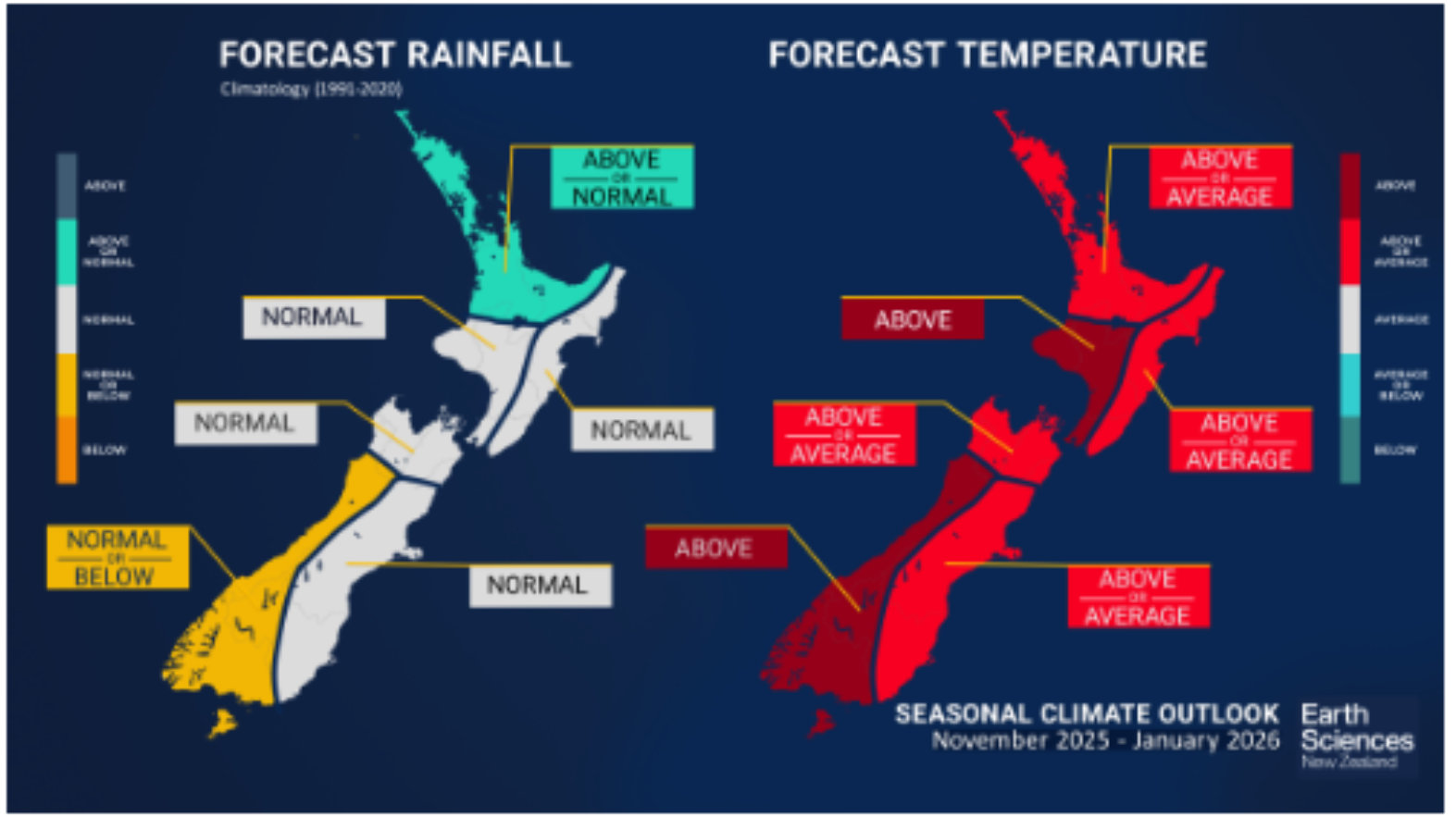The Wholesale Electricity Market
Spot prices in the wholesale electricity market decreased significantly again during October. Average spot prices for the month ranged from $27 in the lower South Island (down from $113 in September), up to $31 in the upper South Island ($125 in September).

The following chart shows average weekly spot prices over the last 2 years. The low prices in October can be clearly seen.

Electricity Demand
Milder weather through October meant that electricity demand was close to the average levels expected for this time of year. As expected, demand is falling off as we move towards summer.

Electricity Generation Mix
Reduced demand, increased hydro generation, and strong wind generation meant thermal generation was almost non-existent for much of the month.

HVDC Transfer
Power transfers on the HVDC link connecting the North and South Islands are important both in showing relative hydro positions and the reliance on thermal power to meet demand. High northward flow tends to indicate a good SI hydro position, whereas the reverse indicates a heavy reliance on thermal power to make up for hydro shortages.
Northward transfer in October remained at the higher levels seen the previous month while southward transfer was minimal.

The Electricity Futures Market
The Futures Market provides an indication of where market participants see the spot market moving in the future. They are based on actual trades between participants looking to hedge their positions (as both buyers and sellers) into the future against potential spot market volatility. They are also a useful proxy for the direction of retail contracts.
The following graph shows Futures pricing for CY 2025, 2026, 2027, 2028 and 2029 at Otahuhu (Auckland) for the last 4 years.

Note that $200/MWh equates to 20c/kWh.
Forward prices were up for most years through October. CAL 2026 increased ending the month at $197.5/MWh – up 5%. CY 2027 price was up 2% at $180 while CY 2028 decreased marginally at $172. CY2029 started being published at the beginning of October, finishing the month unchanged at $164.
Known new generation projects are shown below (additions / removals / changes highlighted in bold).

Hydro Storage
Inflows were well above average in both islands last month, particularly in the SI as shown below.\

The high inflows resulted in storage continuing to increase rapidly through October. Energy storage levels increased 1,137GWh through the month to end at 3,995GWh (90.5% full). Storage is now well above the average level seen at this time of year. The following chart shows the latest breakdown of storage across the main hydro catchments.

Security of supply risks decreased through October with storage levels increasing as shown below.

Snowpack
Snowpack is an important way that hydro energy is stored over the winter months and released as hydro inflows in the spring. The following graph shows that the snowpack in the important Waitaki catchment increased significantly again during October and is now at the maximum level seen in the last 30 years for this time of year.

Climate outlook overview September - November 2025 (from NIWA)
- La Niña conditions have now emerged in the tropical Pacific.
- Both the Southern Oscillation Index (SOI) and the Relative Oceanic Niño Index (RONI) exceeded their respective La Niña thresholds for the month of October.
- More broadly, anomalies in ocean subsurface temperatures, atmospheric convection and circulation patterns across the Pacific are consistent with La Niña conditions.
- The coupling between the ocean and the atmosphere has been likely reinforced by a strong Madden-Julian-Oscillation (MJO) pulse that reached into the Maritime Continent at the end of October.
- Forecasts from Earth Science New Zealand’s (ESNZ) Relative Oceanic Niño Index (RONI) indicate a high probability (about 80%) of La Niña conditions prevailing during the November 2025 –January 2026 period. These new forecasts account for global warming trends in the tropics and are favoured by ESNZ. Traditional international guidance has around a 65% probability of La Niña conditions continuing through the forecast period.
- A minor Sudden Stratospheric Warming (SSW) event developed over Antarctica in September 2025, near the top of the atmosphere. The impacts of this SSW propagated downwards towards through the troposphere (the part of the atmosphere where our weather occurs) throughout October, greatly influencing the unsettled conditions of the month. While a transition to other climate drivers, e.g., La Niña, is expected over the next three months, the SSW may continue to influence conditions during November.
- November will begin with the first period of prolonged, settled weather this spring as an anticyclone (high pressure) dominates. However, it’s likely this will not prevail throughout the entire month, with probable periods of rain from both the north and west. Despite this, a dry lean for the month is expected for most areas, with only the northern North Island at particular risk of running wetter than normal for the month.
- The latter half of the three-month period is expected to see high pressure sit more frequently over or south of the South Island, resulting in an easterly quarter anomaly airflow over the country. Westerly fronts should be reduced in frequency, and there is an elevated risk of lows from the north drifting onto the country.
- The threat for heavy rain makers from the sub-tropics and tropics will be elevated, with the North Island most likely affected by such events.
- The southwest Pacific Tropical Cyclone (TC) season has officially started, ESNZ Tropical Cyclone Outlook for November 2025 – April 2026 indicates a normal or elevated risk for ex-TC interaction for New Zealand.
- Seasonal air temperatures are about equally likely to be near average or above average for all regions of New Zealand, except for the west of both islands, where above average temperatures are most likely.
- November – January rainfall totals are expected to be near normal or above normal for the north of the North Island, and near normal or below normal for the west of the South Island. Near normal rainfall is forecast elsewhere, though the tercile distribution, or probability for other outcomes, in these regions reflects uncertainty in the outlook.
- During November 2025 – January 2026, soil moisture levels and river flows are forecast to be below normal for the east of the North Island, and near or below normal for the north of the North Island and east of the South Island. Near normal soil moisture levels and river flows are expected for the remaining regions of the country.
- On top of the cooling seen in September, SSTs cooled further around parts of New Zealand during October 2025, ending the long running marine heatwaves (MHW) conditions off the west coast of the South Island. MHW conditions persist off the upper North Island and are likely to continue. Seas off the east coast of both islands are currently experiencing below-average temperatures. Coupled General Circulation Model (GCM) forecasts suggest SSTs will be near or slightly above average for the remainder of the year, with warming expected later in the period, particularly off the east coast of the North Island. Monitor the SST update for updates.

The Wholesale Gas Market
Spot gas prices dropped again through October. Prices for the month averaged $12.4/GJ – a 12% decrease compared to September. Average prices remained 46% above what they were at the same time last year. Note that spot gas prices include the cost of carbon (currently around $3/GJ)

On the supply side producers increased or maintained output through August. Maui maintained output at approx.. 42TJ/day. Pohokura increased output – jumping from around 32TJ/day up to 42TJ/day in the middle of the month. McKee / Mangahewa maintained the higher levels of output seen at the end of last month – averaging 69TJ/day through the month. Turangi and Kowhai reduced output averaging just under 50TJ/day.
The following graph shows production levels from major fields over the last 7 years.

Increased supply allowed Methanex to increase usage again – averaging 72TJ/day through the month. Huntly demand reduced initially to around 12TJ/day then falling further to below 5TJ/day at the end of the month.
The following graph shows trends in the major gas users over the last 7 years.

Gas storage is becoming increasingly important as falling production coincides with more variable demand particularly from gas fired electricity generation. The following chart shows how storage at Ahuroa increased through October. It is now close to average levels seen at this time of year over the last few years.

Internationally, LNG netback prices ended the month at $14.42/GJ – down 4% from last month. Forecast prices for 2025 were steady at $16.98/GJ. Forward prices for 2026 were down 4% at $13.78/GJ. (Note that netback prices are indicative of international prices – they are produced by the ACCC and quoted in Australian dollars. They are net of the estimated costs to convert from pipeline gas in Australia to LNG, hence the term “netback”)

New Zealand does not (yet) have an LNG export/import market, so our domestic prices are not directly linked to global prices. The Government announced last month that it intends to build an LNG import terminal in NZ as a measure to improve energy security of supply. The target is for this to be in place in 2027.
LPG is an important fuel for many large energy users, particularly in areas where reticulated natural gas is not available. The contract price of LPG is typically set by international benchmarks such as the Saudi Aramco LPG – normally quoted in US$ per metric tonne.
The following graph shows the Saudi Aramco LPG pricing for the last 4.5 years as well as forecast pricing for the year ahead. Futures pricing were down slightly over the last month and remain trending down through 2026.

The other main contributing factor to LPG prices in New Zealand is the exchange rate against the USD. The exchange rate fell during the month closing at 0.57. This remains near the lowest levels seen in recent years. This would tend to push up LPG prices when quoted in NZD.

The Coal Market
The global energy crisis has been as much about coal as it has gas. The war in the Ukraine has driven energy prices, including coal, up. Prices in October increased ending the month at US$109/T – a 4% rise over the month. These prices are finally returning to levels close to what we expect to see as shown in the following graph of prices over the last 10 years.

Like gas, the price of coal can flow through and have an impact on the electricity market. This month Genesis reported that its coal stockpile is at a 13 year high. On 30 September the stockpile stood at 1.06 million tonnes – a 360,000-tonne increase since the end of June. Genesis says that 500,000 tonnes is the equivalent of about 1,000GWh of electricity storage or 22% of maximum hydro storage in NZ.
Carbon Pricing
NZ has had an Emissions Trading Scheme (ETS) in place since 2008. It has been subsequently reviewed by several governments and is now an “uncapped” price scheme closely linked to international schemes. However, there are “upper and lower guard-rails” set up to prevent wild swings in carbon price that act as minimum and maximum prices. These increased in December 2023 to $173 and $64 respectively. Carbon prices decreased 9% in October to $52.

As the carbon price rises, the cost of coal, gas or other fossil fuels used in process heat applications will naturally also rise. Electricity prices are also affected by a rising carbon price. Electricity prices are set by the marginal producing unit – in NZ this is currently typically coal or gas or hydro generators, with the latter valuing the cost of its water against the former. An increase in carbon price can lead to an increase in electricity prices in the short to medium term (as the marginal units set the price). A carbon price of $50/t is estimated to currently add about $25/MWh (or ~2.5c/kWh) to electricity prices. In the long term the impact should reduce as money is invested in more low-cost renewables and there is less reliance on gas and coal fired generation.
EU Carbon units increased in October to 81.4 Euro/tonne – up 3%. Australian Carbon Units also increased 1% to AUD$38.3
About this Report:
This energy market summary report provides information on wholesale price trends within the NZ Electricity Market. Please note that all electricity prices are presented as a $ per MWh price and all carbon prices as a $ per unit price. All spot prices are published by the Electricity Authority. Futures contract prices are sourced from ASX.
Further information can be found at the locations noted below.
- Transpower publishes a range of detailed information, which can be found here: https://www.transpower.co.nz/power-system-live-data
- The Electricity Authority publishes a range of detailed information, which can be found here: https://www.emi.ea.govt.nz/
- Weather and Climate data – The MetService publishes a range of weather-related information, which can be found here: https://www.metservice.com/
Disclaimer: This document has been prepared for informational and explanatory purposes only and is not intended to be relied upon by any person. This document does not form part of any existing or future contract or agreement between us. We make no representation, assurance, or guarantee as to the accuracy of the information provided. To the maximum extent permitted by law, none of Smart Power Ltd, its related companies, directors, employees or agents accepts any liability for any loss arising from the use of this document or its contents or otherwise arising out of or in connection with it. You must not provide this document or any information contained in it to any third party without our prior consent.
About Smart Power:
Smart Power is a full-service Energy Management consultancy. Apart from Energy Procurement, Smart Power can also provide:
- Technical advice on how to reduce your energy use & emissions
- Sustainability Reporting
- Invoice Management Services
We also offer boutique energy and water billing services for landlords/property developers.
Contact us here or call one of our offices to talk to our experienced staff about how we can assist you with achieving your energy goals.
© Copyright, 2025. Smart Power Ltd




